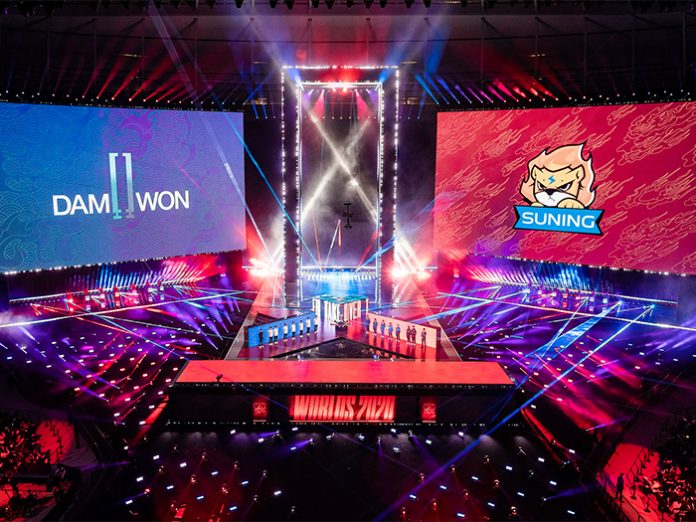The 2020 League of Legends World Championship took place at the new Pudong Football Stadium in Shanghai, China on 25 September to 31 October 2020, boasting a versatile production lighting design by Mat Stovall of LampedUp, featuring Robe lighting fixtures.
A total of 37 Robe RoboSpot systems were part of a large lighting rig for the event – specified by Stovall and Associate LD Trevor Stirlin Burk of Visual Noise Creative – supplied by Christie Lites to the event’s main technical contractor, Creative Technology (CT) Shanghai.
Robert Roth coordinated for Christie Lites, working closely with the CT Shanghai team headed by Aaron Ross Durdin, Sam Tibble and Daniel Sun. Stovall required a “quality white light source” to key talent for the opening and closing shows and during the gaming action, with capacity to cover specific choreographed aspects, plus coach and team ‘moments’ throughout the tournament.
With a massive performance area to cover in the centre of the stadium, Mat was not sure that it would be possible to physically get operators into all the required locations, so RoboSpot was his “go-to” solution.
37 Robe BMFL moving light units were positioned on the downstage trusses, above and below the two giant LED screens onstage that flanked a huge central scenic Paifang arch, and on top of this elegant 33m-high centrepiece of Joe Kale’s scenic design, based on the creative development of Riot Games producers and Michael Figge of Possible.
BMFL FollowSpot and 21 BMFL FollowSpot LT luminaires were partnered with 37 active base stations, linked to individual lights, and operated by 14 people, often jumping between systems. The most experienced operators stayed on all the ‘hero’ action downstage, while others were covering the back lights and some of the more creative angles.
The task of coordinating this with a mostly non-English speaking crew was handed to Zach Matusow, who also called all spot cues in collaboration with CT Shanghai’s crew who helped with the translating and ran some of the RoboSpot units.
The operators were located in a conference room underneath one of the main grandstands, with no windows or line-of-sight to the stage. The team did however have multiple monitors showing broadcast camera feeds giving them eyes on the action independently to what was showing on their own separate RoboSpot BaseStation screens.
By far the most challenging element of installing a RoboSpot system of this magnitude was engineering the control, a task tackled by Network Architect, Tom Buddingh. The RoboSpot control network consisted of 17 Gigabit fibre optic switches and 15 Luminex DMX8 Mk2 nodes, which were essential to act as bridges and transport the RDM communication required to link RoboSpot controllers and moving heads with attached cameras.
Buddingh configured the followspot network with 40 virtual area networks, run over a single piece of fibre or copper wire to allow each camera to have its own “network” link back to the controller, with the operator only able to see a single camera on each controller.
The control room featured six managed switches for RoboSpot BaseStations, four 24 port non-managed gigabit switches, and six Luminex Nodes which enabled each controller to have a discrete feed from the appropriate camera, RDM communication to the appropriate head, and receive signal from the lighting console.
Buddingh also designed the main MA-net / sACN “show lighting” network to control the approximately 3500 fixtures on the main production lighting rig, kept as a completely separate network to reduce traffic on the “RoboSpot” network. To this end, he took a hard DMX feed from a node attached to the “lighting network” into a node connected to the “xpot” network, reducing the hundreds of sACN universes to just five.
With the RoboSpot heads so spread out across the rig and the 100m limitation of copper ethernet cables, Buddingh required a way to distribute the control throughout the venue. “I implemented a hybrid trunk and spider network topology with a couple of main hubs splitting off to distribution points on trusses which accommodated between two and eight RoboSpot followspot heads. These four ‘hubs’ and eight ‘Spider’ distribution points were connected with Neutrik OpticalCon Quad fibre cable.”
Stirlin operated from his home office in LA, with Lighting Director and Programmers Tiffany Keys and Mike Appel working remotely from LA and Florida. Early Bird Visuals assisted Stovall and his lighting design team with renders and pre-visualisation and hosted a Discord session to composite show files.
Geoff Knight and Scotty Beck were “gaffers” on site, while Shaheem Lichtmore was programmed lighting for the play off shows, backstage activations, gamer key lighting, and key light for the local host desk in Shanghai.
Adam Eldridge, Ron Konsur and Brian Davies were involved in coordinating the installation, liaising between the LOL production and CT Shanghai, ConCom Technical Director, Randy Quick and Head of Global eSports Production for Riot Games, Marc Hilko as well as Show Directors, Sam Wrench and Riah Chiu.
South Korea’s DAMWON Gaming defeated China’s Suning 3–1 to claim League of Legends World Championship.






